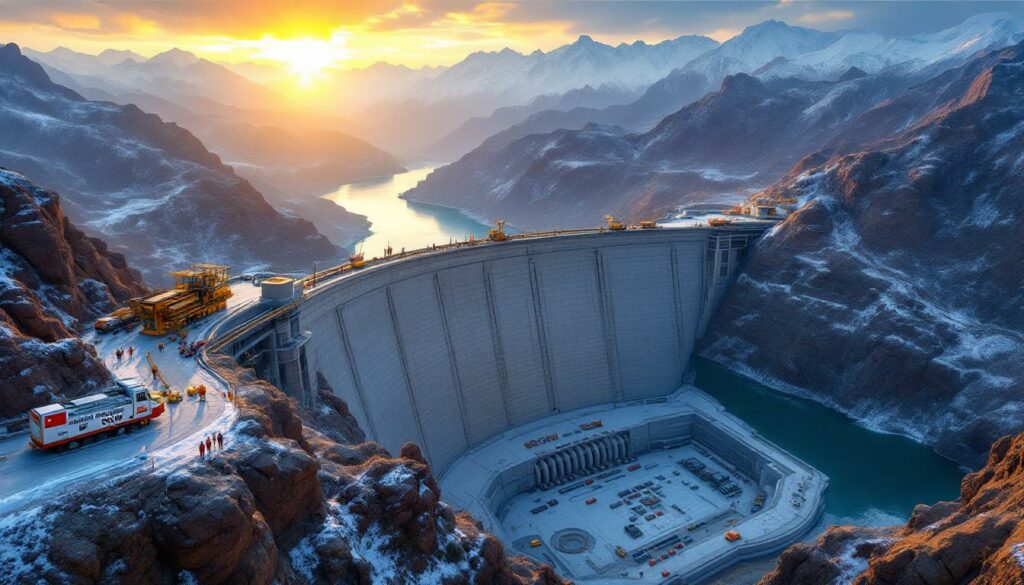What is the World's Largest Hydropower Dam Project in China?
China has begun construction on what will become the world's largest hydropower dam on the Yarlung Tsangpo River (known as the Brahmaputra in India), marking a significant milestone in the nation's renewable energy development. This massive infrastructure project represents China's continued commitment to hydroelectric power as a cornerstone of its energy transition trends.
Located in Tibet's deep river valleys, the dam is being built at a strategic point where the river makes a sharp U-turn before flowing into India. The project showcases China's ambitious vision for clean energy development while raising important questions about transboundary water management.
When completed, this engineering marvel will harness the tremendous power of one of Asia's most significant river systems, transforming the regional energy landscape and reinforcing China's position as the global leader in hydroelectric power generation.
How Does China's New Dam Compare to Existing Hydropower Giants?
Size and Scale Comparison
The new dam on the Yarlung Tsangpo River will dwarf existing hydropower facilities, including China's own Three Gorges Dam. While the Three Gorges Dam currently holds the title of the world's largest hydropower station with a capacity of 22.5 gigawatts (GW), the new project is expected to generate approximately 60 GW upon completion—nearly tripling the output of its predecessor.
To put this scale in perspective, the dam's capacity would exceed the total installed hydropower capacity of most countries. The sheer magnitude of the project represents a quantum leap in hydropower engineering and demonstrates China's willingness to undertake infrastructure development at an unprecedented scale.
The reservoir created by the dam will transform hundreds of kilometers of fast-flowing river into a massive lake, dramatically altering the landscape of this remote Himalayan region. Unlike Three Gorges, which is built in a densely populated area, the Yarlung Tsangpo dam takes advantage of Tibet's sparsely populated valleys to minimize displacement concerns.
Technical Engineering Achievements
The dam's construction involves unprecedented engineering challenges due to the river's location in Tibet's deep canyons and high-altitude terrain. Engineers must contend with:
- Working at elevations exceeding 3,000 meters above sea level, where oxygen levels are significantly reduced
- Managing extreme temperature variations that can range from -20°C in winter to 30°C in summer
- Developing specialized equipment capable of functioning efficiently in high-altitude conditions
- Designing structures to withstand the region's substantial seismic activity, as the dam sits near the collision zone of the Indian and Eurasian tectonic plates
Chinese engineers have developed innovative solutions to address these challenges, including new concrete formulations that can cure properly at high altitudes and low temperatures. The project also employs advanced geological monitoring systems to detect and respond to potential seismic activity.
Environmental Impact Assessment
Unlike previous large-scale dam projects that faced criticism for insufficient environmental consideration, this new development incorporates more comprehensive environmental impact assessments, including:
- Biodiversity conservation measures for endemic species, particularly rare fish and plants found only in the Yarlung Tsangpo basin
- Sediment flow management systems designed to minimize downstream ecological impacts
- Extensive ecological monitoring networks that will track environmental changes before, during, and after construction
- Climate change adaptation considerations that account for changing precipitation patterns in the Himalayan region
Environmental experts note that the project team has conducted detailed studies of the river's ecosystem over several years to develop mitigation strategies. However, independent environmental organizations have expressed concern about the limited transparency regarding these assessments.
Why is China Investing in Massive Hydropower Infrastructure?
Energy Security Strategy
China's investment in the world's largest hydropower dam aligns with its broader energy security objectives:
- Reducing dependency on imported fossil fuels, which currently account for over 70% of China's oil consumption
- Diversifying domestic energy production to create a more resilient power generation portfolio
- Creating reliable power generation capacity in strategically important border regions
- Establishing energy independence in areas that are difficult to supply through conventional power grids
This massive hydroelectric project represents a cornerstone of China's long-term energy security planning, providing a domestic, renewable source of electricity that isn't subject to international market fluctuations or supply chain disruptions.
Climate Commitments and Carbon Reduction
The massive hydropower project supports China's climate goals by:
- Contributing significantly to its 2060 carbon neutrality target announced by President Xi Jinping
- Reducing coal consumption for electricity generation in a country that still relies heavily on coal power
- Lowering national carbon emissions by an estimated 200 million tons annually once fully operational
- Demonstrating China's commitment to renewable energy leadership on the global stage
This single project could account for approximately 2% of the carbon reduction needed for China to meet its climate commitments, making it a strategically important component of the nation's environmental policy. Furthermore, the decarbonisation benefits extend beyond the energy sector, potentially influencing mining and industrial practices throughout the region.
Economic Development Benefits
Beyond energy production, the dam project delivers substantial economic advantages:
- Creating approximately 100,000 construction jobs during the building phase
- Stimulating regional development in Tibet, one of China's least economically developed regions
- Building domestic expertise in advanced hydropower technology that can be exported globally
- Generating export opportunities for Chinese engineering services and construction companies
The economic ripple effects extend well beyond the dam itself, as the project requires massive improvements in regional infrastructure, including roads, bridges, and transmission lines that will benefit local communities long after construction is complete.
What Geopolitical Implications Does the Dam Project Carry?
Cross-Border Water Resource Management
The dam's location on the Yarlung Tsangpo/Brahmaputra river system raises important transboundary considerations:
- Water flow management affecting downstream countries, particularly India and Bangladesh, which depend on the river for agriculture and drinking water
- Potential impacts on agricultural productivity in neighboring nations that rely on seasonal water flows
- Necessity for international water-sharing agreements to ensure equitable resource distribution
- Heightened regional diplomatic engagement on water security issues
India has expressed particular concern about the project, as the Brahmaputra is vital for irrigation in its northeastern states. While China has pledged to operate the dam responsibly, the absence of comprehensive water-sharing treaties has created tension.
Strategic Infrastructure Development
The project represents more than just energy production; it serves as a demonstration of:
- China's advanced engineering and construction capabilities in challenging environments
- Strategic control of vital water resources in a geopolitically sensitive region
- Infrastructure development in border regions that reinforces territorial claims
- Long-term investment in remote territories to strengthen national integration
By developing such significant infrastructure in Tibet, China reinforces its sovereignty in the region while creating permanent installations that serve multiple strategic purposes beyond energy generation.
International Relations Considerations
Construction of the world's largest dam inevitably influences China's relationships with:
- India, which has expressed concerns about water security and potential flooding risks
- Environmental organizations monitoring ecological impacts across national boundaries
- International financial institutions observing the project's development and environmental safeguards
- Global climate action coalitions assessing the contribution to renewable energy targets
The project has become a focal point for discussions about transboundary resource management and highlights the need for stronger international frameworks governing shared water resources.
How Will the Dam Transform Regional Ecosystems?
Habitat Transformation Assessment
The creation of a massive reservoir will fundamentally alter the regional ecosystem:
- Conversion of fast-flowing riverine habitats to lake environments, affecting species adapted to river conditions
- Changes in local climate patterns due to the formation of large water bodies, potentially increasing humidity and altering precipitation
- Altered migration routes for native species, particularly fish that travel upstream to spawn
- Creation of new ecological niches and habitats that may benefit some species while threatening others
Ecologists are particularly concerned about endemic fish species that have evolved to thrive in the unique conditions of the Yarlung Tsangpo, as these species may struggle to adapt to reservoir conditions.
Biodiversity Conservation Measures
To mitigate ecological impacts, the project incorporates:
- Fish passage systems designed specifically for migratory species native to the Yarlung Tsangpo
- Protected zones for endangered flora and fauna identified during environmental impact studies
- Habitat restoration programs in adjacent areas to preserve genetic diversity
- Long-term biodiversity monitoring initiatives to track ecosystem changes and guide adaptive management
Chinese authorities have emphasized that these conservation measures exceed those implemented in previous dam projects, reflecting increased environmental awareness and technological advancement.
Sediment Management Innovations
Unlike earlier dam projects that struggled with sediment accumulation, this development includes advanced sediment management:
- Specialized sluice gates designed for periodic sediment flushing to maintain reservoir capacity
- Reduced downstream erosion through controlled releases that mimic natural flow patterns
- Preservation of nutrient transport for agricultural areas dependent on river-borne minerals
- Monitoring systems to assess long-term river morphology changes and adapt management accordingly
These innovations address one of the key sustainability challenges facing large hydropower projects—the gradual loss of capacity due to sediment buildup—while also minimizing downstream impacts.
What Technical Innovations Make This Dam Unique?
High-Altitude Construction Techniques
Building at extreme elevations requires specialized approaches:
- Cold-weather concrete formulations containing specialized additives that cure properly at low temperatures and high altitudes
- Logistics systems designed for limited-access mountain terrain, including cable-based material transport
- Worker health protocols addressing altitude sickness and reduced oxygen environments
- Equipment modifications for thin-air operation, including adjusted combustion engines and specialized hydraulic systems
These innovations will likely advance construction technology globally, as many of the solutions developed for this project can be applied to other high-altitude infrastructure developments. The industry evolution trends visible in this project showcase how engineering challenges drive technological advancement.
Advanced Power Generation Systems
The dam incorporates cutting-edge hydroelectric technology:
- Variable-speed turbines that optimize generation at different flow rates, maximizing efficiency year-round
- Digital twin modeling for predictive maintenance, reducing downtime and extending equipment life
- Integrated pumped storage capabilities for grid stabilization during periods of low demand
- Ultra-high voltage transmission systems to minimize power loss over the long distances to urban centers
These advanced systems represent the state of the art in hydroelectric generation and will serve as a global benchmark for future projects.
Climate Resilience Features
Designed for long-term operation in a changing climate:
- Flood control systems sized for increased precipitation events predicted by climate models
- Drought management capabilities through strategic reservoir operation and water conservation
- Structural reinforcement against extreme weather events, including heavier rainfall and potential landslides
- Adaptive management protocols based on continuous climate monitoring and hydrological data analysis
These features acknowledge the reality of climate change and ensure the dam will remain functional and safe throughout its operational lifespan, even as weather patterns become more unpredictable.
When Will the Dam Be Completed and Operational?
Construction Timeline and Milestones
The project follows an ambitious but measured development schedule:
- Initial site preparation and access road construction: 2025-2026
- Main dam foundation work: 2026-2028
- Concrete pouring and structural development: 2028-2031
- Turbine installation and testing: 2031-2033
- Full operational capacity expected: 2035
This timeline reflects the enormous scale and technical complexity of the project, as well as the challenging environment in which construction must take place.
Phased Implementation Approach
Rather than waiting for complete construction, the project will be implemented in stages:
- First generating units operational by 2030, allowing for early power production and revenue generation
- Incremental capacity additions through 2035 as additional turbines come online
- Full reservoir filling conducted over multiple years to minimize downstream impact
- Gradual integration into the national power grid to ensure system stability
This phased approach allows for testing and refinement of systems while providing earlier returns on investment and reducing the impact of sudden changes to river flow patterns.
Long-term Operational Planning
The dam's operational lifespan extends well into the future:
- Designed for a minimum 100-year operational period, with core structures built to last centuries
- Maintenance schedules established for critical components based on predictive wear modeling
- Upgrading pathways identified for future technology integration as turbine efficiency improves
- Decommissioning considerations incorporated into initial design, though implementation would be generations away
This long-term planning perspective reflects the permanence of large dam projects and the need to consider multi-generational impacts and benefits.
How Does This Project Compare to Global Renewable Energy Trends?
Hydropower vs. Other Renewable Sources
While massive in scale, the dam project represents one component of China's diverse renewable strategy:
- Complementing rather than replacing solar and wind investments, which continue to grow at record pace
- Providing baseload power stability that intermittent renewables lack, enhancing grid reliability
- Offering energy storage capabilities through reservoir management that supports broader renewable integration
- Demonstrating continued commitment to established renewable technologies while exploring emerging options
The dam exemplifies China's "all of the above" approach to renewable energy, which pursues multiple technologies simultaneously rather than focusing exclusively on the newest innovations.
Integration with Modern Grid Systems
The dam's design incorporates advanced grid integration features:
- Smart control systems for responsive power generation based on real-time demand data
- Load-following capabilities to support variable renewable sources like wind and solar
- Black start functionality for grid resilience, allowing the dam to restart the power grid after major outages
- Cross-regional transmission infrastructure that strengthens connections between western generation and eastern consumption
These features position the dam as a cornerstone of China's next-generation power grid, designed to accommodate a much higher percentage of renewable energy.
Renewable Energy Investment Comparison
China's investment in this single hydropower project exceeds:
- The total renewable energy budgets of many developed nations over multiple years
- Annual global investment in geothermal energy development by a significant margin
- Typical five-year hydropower development budgets worldwide
- Many countries' complete energy infrastructure modernization plans
This extraordinary level of investment demonstrates China's unmatched commitment to renewable energy infrastructure and its ability to mobilize resources for strategic projects on a scale few other nations can match. For those looking at investment opportunities 2025, this project highlights the scale of resource allocation in renewable energy sectors.
What Economic Benefits Will the Dam Provide?
Energy Production Value
The dam's electricity generation represents substantial economic output:
- Annual production value exceeding $40 billion at current electricity prices
- Reduced fossil fuel imports worth approximately $15 billion annually
- Carbon credit potential under international climate agreements, representing additional value
- Energy export opportunities to neighboring countries, creating new revenue streams
Over its operational lifespan, the dam is expected to generate electricity valued at trillions of dollars, making it one of the most economically productive infrastructure investments in history.
Employment and Skill Development
Beyond construction jobs, the project creates lasting economic benefits:
- Permanent operational positions for approximately 5,000 workers
- Development of specialized engineering expertise that can be applied to future projects
- Training programs for hydropower technicians, creating high-skill employment in remote regions
- Research opportunities for renewable energy innovation at dedicated facilities near the dam
These employment benefits extend far beyond the construction phase, creating sustainable economic development in regions that have historically struggled with limited opportunities.
Regional Development Impacts
The project serves as a catalyst for broader economic transformation:
- Improved transportation infrastructure in remote regions, including highways and bridges built for construction
- Development of tourism opportunities around the reservoir, creating new service industry jobs
- Enhanced flood control benefits for downstream agricultural areas, improving crop yields and reducing disaster losses
- Irrigation potential for expanded agricultural production in areas previously limited by water availability
These secondary benefits may ultimately exceed the direct value of electricity generation, transforming the development trajectory of the entire region. According to recent reports from Bloomberg, the total investment in this project could reach $167 billion, making it one of the most expensive infrastructure projects in history.
FAQ: China's World's Largest Hydropower Dam
Will the dam affect water supply to downstream countries?
The dam's operation will alter natural river flow patterns, but China has stated it will implement responsible water management practices that consider downstream needs. International water-sharing agreements will be crucial for ensuring equitable resource distribution. During the dry season, controlled releases from the reservoir could potentially provide more consistent water flow than natural patterns, but this depends on operational decisions that balance power generation with downstream needs.
How does the dam contribute to China's climate goals?
Once operational, the dam will prevent approximately 200 million tons of carbon emissions annually by replacing coal-fired power generation, significantly contributing to China's pledge to achieve carbon neutrality by 2060. This represents approximately 2% of China's current annual emissions, making the dam a crucial component of the nation's climate strategy. The clean electricity generated will power industrial development without increasing carbon footprint.
What happens to communities in the reservoir area?
The project includes a comprehensive relocation program for affected communities, with new settlements being constructed with improved infrastructure, services, and economic opportunities compared to original locations. Unlike earlier dam projects that faced criticism for inadequate compensation, this program aims to ensure relocated communities experience an improvement in living standards. Cultural heritage preservation is also incorporated into relocation planning.
How will the dam handle earthquake risks in the region?
The dam's design incorporates advanced seismic safety features, including flexible structural elements, enhanced foundation reinforcement, and comprehensive monitoring systems to detect and respond to geological activity. Engineers have conducted extensive geological surveys to understand fault lines and potential risks. The dam structure itself exceeds international safety standards for seismic resilience, with multiple redundant safety systems.
What measures protect fish and wildlife in the river ecosystem?
The project includes fish passage systems, habitat conservation areas, and ecological flow requirements designed to maintain
Want to Catch the Next Major Mineral Discovery?
Stay ahead of the market with Discovery Alert's proprietary Discovery IQ model, delivering instant notifications on significant ASX mineral discoveries straight to your inbox. Explore our dedicated discoveries page to understand why major mineral discoveries can lead to exceptional returns, and begin your 30-day free trial today to gain your market-leading advantage.




